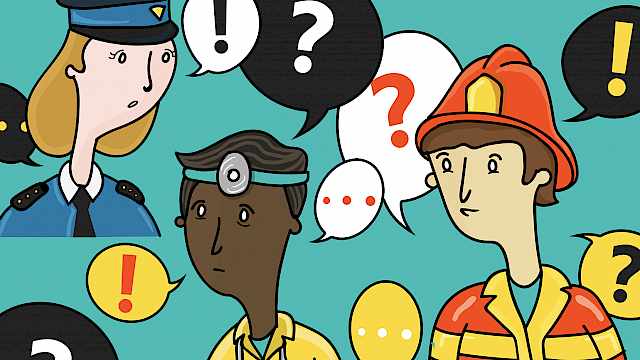Effective emergency responding is of vital importance to public life. In the UK, an emergency is defined as “an event or situation that threatens serious damage to human welfare or to the environment in a place in the UK, or war/terrorism which threatens serious damage to the security of the UK” (Civil Contingencies Act, 2004, S1.1). When an emergency goes beyond routine it is declared as a major incident, requiring “the implementation of special arrangements by one or more Category 1 responders” (Cabinet Office, 2012, pg. 10), such as the Police, Ambulance and Fire Services working alongside Local Authorities, the Environment Agency, Marine and Coastguard Agency and NHS trusts, Public Heath England, and Port Health authorities. A major incident requires emergency teams to temporarily combine their expertise to deal with a situation that would otherwise be impossible to manage by a single team, demanding effective collaboration within as well as between teams (Brown et al., 2021; Curnin et al., 2015a). This makes them especially challenging workplace contexts by being non-routine and requiring collaboration between sub-teams who generally work independently of each other (Bharosa et al., 2010).
The structure that is typically used by teams operating in complex and demanding task environments is a multiteam system (MTS): a network of teams, working towards one collective goal (for example, emergency services ‘saving life’) whilst pursuing various interdependent goals (for example, police safely cordoning the area, firefighters extracting victims, paramedics treating and transporting patients to hospital) (Fleştea et al., 2017; Marks et al., 2001; Mathieu et al., 2001). For an MTS to be effective, sub-teams must align their behaviours, combining their, potentially disparate, command structures, cultures and procedures (Brown et al., 2021). In the UK, large scale disasters, such as the Manchester Arena Bombing (2017), London Bridge Attack (2019), and the Grenfell Tower Fire (2017) amongst others, have raised the profile of the necessity of effective multi-team coordination and, sadly, how its attainment can be elusive in practice.
In this paper, we will systematically review the literature on interoperability by considering the UK emergency services, who have spent the past decade trying to improve joint working between the blue light services via a programme of changes in doctrine and training.
In this paper, we will systematically review the literature on interoperability by considering the UK emergency services, who have spent the past decade trying to improve joint working between the blue light services via a programme of changes in doctrine and training. In 2012, the Joint Emergency Services Interoperability Programme (JESIP, 2013, 2016a, 2021) was established to improve joint working between the UK emergency services. This was in response to government-level acknowledgement that the emergency services had not been working well together at major incidents. These failings were highlighted in the Pollock Report (2013), which evaluated 32 major incidents from the 1980s-2000s and identified repeated failures of interoperability. Pollock (2013) defined interoperability as “the extent to which organisations can work together coherently as a matter of course” (p.8) and warned that procedural changes alone were not enough to achieve effective joint working. He argued that, for interoperability to be fully embedded, there needed to be a concerted effort to shape organisational culture, attitudes, values, and beliefs. Simply instructing emergency responders to cooperate better is not enough to achieve the cultural changes required to entrench interoperability within the working practice of responders (Thomas et al., 2010).
The focus of JESIP since its inception has been the development of the Joint Doctrine (2013, 2016a, 2021). This doctrine provides emergency responders with a framework for the actions they should take when working together. For example, ensuring co-location at a scene on arrival, using jargon free language, adopting a shared “joint decision model” to structure collective decision-making and action. It was intended to supplement agency specific response plans and the joint training that emergency services organisations already received. However, since its inception, the challenges associated with interoperability have not abated. Indeed, JESIP’s focus has been limited to the “blue lights services” despite their regular interaction with non-blue light organisations during emergencies (e.g., Environment Agency, Coast Guard). Further, JESIP training has predominantly focused on command-level decision-makers, failing to recognise the important role that operational staff play in a multi-agency response. The Manchester Arena Inquiry (Saunders, 2022), which evaluated the emergency response to the 2017 terrorist attack that resulted in the deaths of 22 innocent victims, heavily criticised JESIP. Saunders, who led the enquiry, argued that JESIP was not embedded into the “muscle memory” of responders, meaning that under stress they abandoned joint principles and operated in silos. This echoes the warnings by Pollock (2013) that, for interoperability to be achieved, it must be rooted within the organisational culture of emergency workers.
Culture is socially constructed around the beliefs, values, and attitudes of an organisation’s members (Jorritsma & Wilderom, 2011) and is essential to informing how an organisation operates. However, to date, culture has not been a focus of JESIP. The consideration of the psychological processes linked to how interoperability can be better embedded into the social fabric of an organisation are just as, if not more, important than the practical arrangements that JESIP has so far prioritised. Despite JESIPs best efforts, lessons identified from previous incidents continue not to be learned or put into practice. Our systematic review will take a first step in developing our understanding of interoperability through a psychological lens. We suggest that conclusions have application to any high reliability organisation where disparate sub-teams must work together in physically, psychologically, and interpersonally demanding contexts (Orasanu & Lieberman, 2011).
Systematic Review Aims
A core problem with the term interoperability is that definitions of it vary or are omitted entirely. JESIP’s own definition (“working together coherently as a matter of routine”) is vague and creates potential for confusion and lack of agreement over what joint working means in practice. To improve interoperability, we must first reconsider what it means. Second, there is no clear evidence base for the principles outlined in JESIP’s joint doctrine. Although common-sense logic suggests principles like co-location might be important for interoperability, there has been no research to investigate these underpinning principles directly. The principles outlined by JESIP are largely structural and have paid little consideration to psychological and group-level processes that would be trained for in different ways (e.g., trust building exercises). This review is essential to developing an understanding on what precisely interoperability is and how we can embed it within organisational culture. Taken together, this systematic review has three goals, to:
- Establish a concrete definition of “interoperability”
- Identify what interoperability looks like with reference to existing structural principles
- Identify how interoperability can be achieved by categorising the important psychological principles that underpin it
Read more
Abdeen, F.N., Fernando, T., Kulatunga, U., Hettige, S., & Ranasinghe, K.D.A. (2021). Challenges in multi-agency collaboration in disaster management: A Sri Lankan perspective. International Journal of Disaster Risk Reduction, 62, Article 102399. https://doi.org/10.1016/j.ijdrr.2021.102399
Alison, L., Power, N., van den Heuvel, C., Humann, M., Palasinksi, M., & Crego, J., (2015). Decision inertia: Deciding between least worst outcomes in emergency responses to disasters. Journal of Occupational and Organizational Psychology, 88, 295–321. https://doi.org/10.1111/joop.12108
Allen, D.K., Karanasios, S., & Norman, A., (2014). Information sharing and interoperability: the case of major incident management. European Journal of Information Systems, 23(4), 418–432. https://doi.org/10.1057/ejis.2013.8
Ashforth, B. E., & Mael, F. (1989). Social identity theory and the organization. The Academy of Management Review, 14(1), 20–39. https://doi.org/10.2307/258189
Ashforth, B., Harrison, S. H., & Corley, K. (2008). Identification in organizations: An examination of four fundamental questions. Journal of Management, 34(3), 325-374. https://doi.org/10.1177/0149206308316059
ATIS, (2019). Glossary – ATIS Telecom Glossary. https://glossary.atis.org/
Avanzi, D. da S., Foggiatto, A., dos Santos, V.A., Deschamps, F., & de Freitas Rocha Loures, E., (2017). A framework for interoperability assessment in crisis management. Journal of Industrial Information Integration, 5, 26–38. https://doi.org/10.1016/j.jii.2017.02.004
Bharosa, N., Lee, J., & Janssen, M., (2010). Challenges and obstacles in sharing and coordinating information during multi-agency disaster response: Propositions from field exercises. Information Systems Frontiers. 12, 49–65. https://doi.org/10.1007/s10796-009-9174-z
Brown, O., Power, N., & Conchie, S.M., (2021). Communication and coordination across event phases: A multi‐team system emergency response. Journal of Occupational and Organizational Psychology, 94(3), 591–615. https://doi.org/10.1111/joop.12349
Cabinet Office, (2012). Glossary: revision to Emergency Preparedness. HM Government, London
Cabinet Office, (2013). Emergency Response and Recovery: Non statutory guidance accompanying the Civil Contingencies Act 2004. HM Government, London.
Campbell, L., Torres, E., Zaccaro, S., Zhou, S., Hedrick, K., Wallace, D., Luning, C., & Zakzewski, J., (2022). Examining Multiteam Systems Across Context and Type: A Historiometric Analysis of Failed MTS Performance. Frontiers in Psychology, 13, Article 813624. https://doi.org/10.3389/fpsyg.2022.813624
Capiola, A., Baxter, H.C., Pfahler, M.D., Calhoun, C.S., & Bobko, P., (2020). Swift Trust in Ad Hoc Teams: A Cognitive Task Analysis of Intelligence Operators in Multi-Domain Command and Control Contexts. Journal of Cognitive Engineering and Decision Making, 14(3), 218–241. https://doi.org/10.1177/1555343420943460
Charman, S., (2015). Crossing cultural boundaries. International Journal of Emergency Services. 4(2), 158–176. https://doi.org/10.1108/IJES-07-2014-0011
Charman, S., (2014). Blue light communities: Cultural interoperability and shared learning between ambulance staff and police officers in emergency response. Policing & Society, 24(1), 102–119. https://doi.org/10.1080/10439463.2013.784306
Charman, S., (2013). Sharing a laugh: The role of humour in relationships between police officers and ambulance staff. International journal of sociology and social policy, 33(3), 152–166. https://doi.org/10.1108/01443331311308212
Civil Contingencies Act, 2004. c.36 Available at: https://www.legislation.gov.uk/ukpga/2004/36/contents
Conroy, S., Helne, C.A., Shore, L., & Stelman, S. (2017). Where there is light, there is dark: a review of the detrimental outcomes of high organizational identification. Journal of Organizational Behavior, 38, 184-203. https://doi.org/10.1002/job.2164
Crisp, R.J., Walsh, J., & Hewstone, M. (2006). Crossed categorization in common ingroup contexts. Personality and Social Psychology Bulletin, 32(9), 1204-1218. https://doi.org/10.1177/0146167206289409
Curnin, S., & Owen, C., (2014). Spanning Organizational Boundaries in Emergency Management. International Journal of Public Administration, 37(5), 259–270. https://doi.org/10.1080/01900692.2013.830625
Curnin, S., Owen, C., Paton, D., & Brooks, B., (2015a). A theoretical framework for negotiating the path of emergency management multi-agency coordination. Applied Ergonomics, 47, 300–307. https://doi.org/10.1016/j.apergo.2014.10.014
Curnin, S., Owen, C., Paton, D., Trist, C., & Parsons, D., (2015b). Role Clarity, Swift Trust and Multi-Agency Coordination. Journal of Contingencies and Crisis Management, 23(1), 29–35. https://doi.org/10.1111/1468-5973.12072
Curnin, S., Owen, C., & Trist, C., (2014). Managing the constraints of boundary spanning in emergency management. Cognition, Technology & Work, 16, 549–563. https://doi.org/10.1007/s10111-014-0285-z
Davidson, L., Carter, H., Drury, J., Amlot, R., & Haslam, S., (2022). Advancing a social identity perspective on interoperability in the emergency services: Evidence from the Pandemic Multi-Agency Response Teams during the UK COVID-19 response. International Journal of Disaster Risk Reduction, 77. Article 103101 https://doi.org/10.1016/j.ijdrr.2022.103101
Desourdis, R. & Contestabile, J. (2011). Information sharing for situational understanding and command coordination in emergency management and disaster response, Presented at the 2011 IEEE International Conference on Technologies for Homeland Security (HST), pp. 26–32. https://doi.org/10.1109/THS.2011.6107843
Doyle, E.E.H., Paton, D., & Johnston, D.M., (2015). Enhancing scientific response in a crisis: evidence-based approaches from emergency management in New Zealand. Journal of Applied Volcanology, 4(1). 1-26 https://doi.org/10.1186/s13617-014-0020-8
Drach-Zahavy, A., & Somech, A. (1999). Constructive thinking: A complex coping variable that distinctively influences the effectiveness of specific difficult goals. Personality and Individual differences, 27, 969–984. https://doi.org/10.1016/S0191-8869(99)00041-0
Eklund, A., Karlsson, S., & Gyllencreutz, L., (2022). Building “common knowledge” when responding to major road tunnel incidents: an inter-organisational focus group study. International Journal of Emergency Services, https://doi.org/10.1108/IJES-02-2022-0006
Elliot, A. J. (2006). The hierarchical model of approach-avoidance motivation. Motivations and Emotion, 30, 111–116. https://doi.org/10.1007/s11031-006-9028-7
Elmhadhbi, L., Karray, M.-H., Archimede, B., Otte, J.N., & Smith, B., (2020). A Semantics-Based Common Operational Command System for Multiagency Disaster Response. IEEE Transactions on Engineering Management, 69(6), 1–15. https://doi.org/10.1109/TEM.2020.3013109
European Commission, (2017). New European Interoperability Framework: Promoting seamless services and data flows for European public administrations. European Union, Luxembourg.
Eyerman, J., & Strom, K.J., (2008). Multiagency Coordination and Response: Case Study of the July 2005 London Bombings. International Journal of Comparative & Applied Criminal Justice, 32(1), 89–109.
Eyre, A., (2015). Communication and Fire Service Organisations: New Reflections on an Old Challenge. International Fire Service Journal of Leadership & Management, 9, 11–20.
Fleştea, A.M., Fodor, O.C., Curşeu, P.L., & Miclea, M., (2017). “We didn’t know anything, it was a mess!” Emergent structures and the effectiveness of a rescue operation multi-team system. Ergonomics, 60(1), 44–58. https://doi.org/10.1080/00140139.2016.1162852
Foddy, M., Platow, M. J., & Yamagishi, T. (2009). Group-Based Trust in Strangers: The Role of Stereotypes and Expectations. Psychological Science, 20(4), 419–422. https://doi-org/10.1111/j.1467-9280.2009.02312.x
Gaertner, S.L., Dovido, J.F., Anastasio, P.A., Bachman, B.A., & Rust, M. (1993). The common ingroup identity model: recategorization and the reduction of intergroup bias. European Review of Social Psychology, 4(1), 1-26. https://doi.org/10.1080/14792779343000004
Gollwitzer, P. M. (1999). Implementation intentions: Strong effects of simple plans. American Psychologist, 54, 493–503. https://doi.org/10.1037/0003-066X.54.7.493
Handley, H.A.H., (2014). A network model for human interoperability. Human Factors, 56(2), 349–360. https://doi.org/10.1177/0018720813493640
Hardin, R. (2001). Conceptions and explanations of trust. In K. S. Cook (Ed.), Trust in society (pp. 3–39). Russell Sage Foundation.
Haslam, S.A., Haslam, C., Cruwys, T., Jetten, J., Bentley, S.V., Fong, P., & Steffens, N.K., (2022). Social identity makes group-based social connection possible: Implications for loneliness and mental health. Current Opinion in Psychology, 43, 161–165. https://doi.org/10.1016/j.copsyc.2021.07.013
House, A., Power, N., & Alison, L., (2014). A systematic review of the potential hurdles of interoperability to the emergency services in major incidents: Recommendations for solutions and alternatives. Cognition, Technology & Work, 16(3), 319–335. https://doi.org/10.1007/s10111-013-0259-6
Iveson, R.L., (2022). The effectiveness of learning from lessons in UK Emergency Management. University of Wolverhampton.
JESIP, (2013). Joint Doctrine: The Interoperability Framework (1st edition). Home Office: London
JESIP, (2016a). Joint Doctrine: The Interoperability Framework (2nd Edition). Home Office: London
JESIP, (2016b). Joint Doctrine Supporting Document: Strategic Co-ordinating Group Role and Responsibilities. Home Office: London
JESIP, (2021). Joint Doctrine: The Interoperability Framework (3rd edition). Home Office: London
Jorritsma, P., & Wilderom, C. (2012). Failed culture change aimed at more service provision: A test of three agentic factors. Journal of Organizational Change Management, 25(3), 364-391.
Kapucu, N., (2006). Interagency Communication Networks During Emergencies: Boundary Spanners in Multiagency Coordination. American Review of Public Administration, 36(2), 207-225.
Kirkham, B., (2009). CBRN preparedness in a small community: How the Isle of Man has integrated responding and support services. Journal of Business Continuity & Emergency Planning, 3(2), 153–160.
Kwon, G.H., Smith-Jackson, T.L., & Bostian, C.W. (2009). Redefining Interoperability: Understanding Police Communication Task Environments. [conference paper] In: Salvendy, G., Smith, M.J. (eds) Human Interface and the Management of Information. Information and Interaction. Human Interface 2009. Lecture Notes in Computer Science, vol 5618. Springer, Berlin, Heidelberg. https://doi.org/10.1007/978-3-642-02559-4_86
Kwon, G.H., Smith-Jackson, T.L., & Bostian, C.W. (2011) Socio-Cognitive Aspects of Interoperability: Understanding Communication Task Environments among Different Organizations. ACM Transactions on Computer-Human Interaction, 18(4), Article 20. http://doi.acm.org/10.1145/2063231.2063234
Locke, E. A., & Latham, G. P. (1990). A theory of goal setting and task performance. Englewood Cliffs, NJ: Prentice-Hall.
Locke, E. A., & Latham, G. P. (2006). New direction in goal-setting theory. Current Directions in Psychological Science, 15, 265–268. https://doi.org/10.1111/j.1467-8721.2006.00449.x
Marks, M.A., Mathieu, J.E., & Zaccaro, S.J., (2001). A Temporally Based Framework and Taxonomy of Team Processes. The Academy of Management Review, 26(3), 356–376. https://doi.org/10.2307/259182
Mathieu, J.E., Marks, M.A., & Zaccaro, S.J., (2001). Multi-team systems, in: Anderson, N., Ones, D., Sinangil, H.K., Viswesvaran, C. (Eds.), International Handbook of Work and Organizational Psychology. pp. 289–313.
McAleavy, T., & Rhisiart, M., (2019). Harnessing the power of metaphor: Uncovering a hidden language of interoperability within the natural speech of emergency managers. International Journal of Emergency Management, 15(1), 1–25.
McAllister, D.J., (1995). Affect- and Cognition-Based Trust as Foundations for Interpersonal Cooperation in Organizations. The Academy of Management Journal, 38(1), 24–59. https://doi.org/10.2307/256727
Metz, A., Jensen, T., Farley, A., Boaz, A., Bartley, L., & Villodsas, M. (2022). Building trusting relationships to support implementation: A proposed theoretical model. Frontiers in Health Services. https://doi.org/10.3389/frhs.2022.894599
Meyerson, D., Weick, K.E., & Kramer, R.M., (1996). Swift Trust and Temporary Groups, in: Kramer, R.M., Tyler, T.R. (Eds.), Trust in Organizations: Frontiers of Theory and Research. Sage Publications, Inc., pp. 166–195.
Mitchell, R.J., Parker, V., & Giles, M. (2011). When do interprofessional teams succeed? Investigating the moderating roles of team and professional identity in interprofessional effectiveness. Human Relations, 64(10), 1321-1343.
Moher, D., Shamseer, L., Clarke, M., Ghersi, D., Liberati, A., Petticrew, M., Shekelle, P., Stewart, L.A., & PRISMA-P Group, (2015). Preferred reporting items for systematic review and meta-analysis protocols (PRISMA-P) 2015 statement. Systematic Review, 4, Article 1. https://doi.org/10.1186/2046-4053-4-1
Mohr, J., & Spekman, R., (1994). Characteristics of Partnership Success: Partnership Attributes, Communication Behavior, and Conflict Resolution Techniques. Strategic Management Journal, 15(2), 135–152.
National Policing Improvement Agency, (2009). Guidance on Multi-agency Interoperability. National Policing Improvement Agency: London
Neville, K., O’Riordan, S., Pope, A., Rauner, M., Rochford, M., Madden, M., Sweeney, J., Nussbaumer, A., McCarthy, N., & O’Brien, C., (2016). Towards the development of a decision support system for multi-agency decision-making during cross-border emergencies. Journal of Decision Systems, 25(1), 381–396. https://doi.org/10.1080/12460125.2016.1187393
Noran, O., (2014). Collaborative disaster management: An interdisciplinary approach. Computers in Industry, 65, 1032–1040. https://doi.org/10.1016/j.compind.2014.04.003
Noran, O., & Bernus, P., (2011). Effective Disaster Management: An Interoperability Perspective, in: Meersman, R., Dillion, T., Herrero, P. (Eds.) [conference paper]. Presented at the ON THE MOVE TO MEANINGFUL INTERNET SYSTEMS: OTM 2011 WORKSHOPS, pp. 112–121.
O’Brien, A., Read, G.J.M., & Salmon, P.M., (2020). Situation Awareness in multi-agency emergency response: Models, methods and applications. International Journal of Disaster Risk Reduction, 48, Article 101634. https://doi.org/10.1016/j.ijdrr.2020.101634
Page, M.J., Moher, D., Bossuyt, P.M., Boutron, I., Hoffmann, T.C., Mulrow, C.D., Shamseer, L., Tetzlaff, J.M., Akl, E.A., Brennan, S.E., Chou, R., Glanville, J., Grimshaw, J.M., Hróbjartsson, A., Lalu, M.M., Li, T., Loder, E.W., Mayo-Wilson, E., McDonald, S., … McKenzie, J.E., (2021). PRISMA 2020 explanation and elaboration: updated guidance and exemplars for reporting systematic reviews. British Medical Journal, 372, Article n160. https://doi.org/10.1136/bmj.n160
Parry, J., Verhaeghe, S. & Enback, S. (2014). Emergency Services Interoperability Research Wave 2: Report and Recommendations. Skills for Justice https://www.jesip.org.uk/wp-content/uploads/2022/03/JESIP_Workforce_Survey_2_Execu.pdf
Pollock, K., (2013). Review of Persistent Lessons Identified Relating to Interoperability from Emergencies and Major Incidents since 1986. Cabinet Office, London.
Power, N., (2018). Extreme teams: Toward a greater understanding of multiagency teamwork during major emergencies and disasters. American Psychologist., 73(4), 478–490. https://doi.org/10.1037/amp0000248
Power, N., & Alison, L. (2017a). Offence or defence? approach and avoid goals in the multi-agency emergency response to a simulated terrorism attack. Journal of Occupational and Organizational Psychology, 90(1), 51-76. https://doi.org/10.1111/joop.12159
Power, N., & Alison, L., (2017b). Redundant deliberation about negative consequences: Decision inertia in emergency responders. Psychology, Public Policy, and Law, 23(2), 243–258. https://doi.org/10.1037/law0000114
Pugh, D.S., Hickson, D.J., Hinings, C.R., & Turner, C., (1968). Dimensions of Organization Structure. Administrative Science Quarterly, 13(1), 65–105. https://doi.org/10.2307/2391262
Radburn, M., Stott, C., Bryant, R., Morgan, B., Tallent, D., & Davidson, L., (2022). Group processes and interoperability: A longitudinal case study analysis of the UK’s civil contingency response to Covid-19. Journal of Contingencies and Crisis Management, 1-13 https://doi.org/10.1111/1468-5973.12424
Rauner, M.S., Niessner, H., Odd, S., Pope, A., Neville, K., O’Riordan, S., Sasse, L., & Tomic, K., (2018). An advanced decision support system for European disaster management: the feature of the skills taxonomy. Central European Journal of Operations Research, 26(2), 485–530. https://doi.org/10.1007/s10100-018-0528-9
Redshaw, S., Ingham, V., & Loftus, S., (2015). Emergency decision making: an exploration of tensions between communities of practice. International Journal of Emergency Management, 11(1), 62–75.
Rotter, J.B., (1980). Interpersonal trust, trustworthiness, and gullibility. American Psychologist, 35, 1–7. https://doi.org/10.1037/0003-066X.35.1.1
Salmon, P., Stanton, N., Jenkins, D., & Walker, G., (2011). Coordination during multi-agency emergency response: issues and solutions. Disaster Prevention and Management, 20(2), 140–158. https://doi.org/10.1108/09653561111126085
Sanders, C.B., (2014). Need to know vs need to share: Information technology and the intersecting work of police, fire, and paramedics. Information, Communication & Society, 17(4), 463–475. https://doi.org/10.1080/1369118X.2014.891632
Saunders, S.J., (2022). Manchester Arena Inquiry Volume 2: Emergency Response (No. 2). Home Office, London. https://www.gov.uk/government/publications/manchester-arena-inquiry-volume-2-emergency-response
Seligman, L., Blaustein, B., Mork, P., Smith, K., & Rothleder, N., (2009). Information Interoperability and Provenance for Emergency Preparedness and Response. Presented at the 2009 IEEE CONFERENCE ON TECHNOLOGIES FOR HOMELAND SECURITY, pp. 521–528.
Skills for Justice, (2013). Emergency Services Interoperability Survey: Report and Recommendations. Skills for Justice https://www.jesip.org.uk/wp-content/uploads/2022/03/JESIP_Workforce_Survey_1_Full_.pdf
Strom, K.J., & Eyerman, J., (2007). Interagency coordination in response to terrorism: Promising practices and barriers identified in four countries. Criminal Justice Studies, 20(2), 131–147. https://doi.org/10.1080/14786010701396871
Tajfel, H., & Turner, J., (1979). An integrative theory of intergroup conflict, in: The Social Psychology of Intergroup Relations. Wadsworth, Monterey, CA.
Thomas, K., Bergethon, P.R., & Reimer, M., (2010). Interoperability for First Responders and Emergency Management: Definition, Need, and the Path Forward. World Medical & Health Policy, 2(3), 161–166. https://doi.org/10.2202/1948-4682.1070
Timmons, R., (2007). Interoperability: Stop Blaming the Radio. Homeland Security Affairs 3 (Article 5) https://www.hsaj.org/articles/153
Tovey, O., Tolson, J., & Vinand, A., (2018). Communication in a crisis in UK ambulance services: What is needed to improve incident communication? Journal of Business Continuity & Emergency Planning, 11(4), 309–316.
Truptil, S., Bénaben, F., & Pingaud, H., (2010). A Mediation Information System to Help to Coordinate the Response to a Crisis. Berlin, Heidelberg: Springer, pp. 173–180. https://doi.org/10.1007/978-3-642-15961-9_20
Turner, J.C., Hogg, M.A., Oakes, P.J., Reicher, S.D., & Wetherell, M.S., (1987). Rediscovering the social group: A self-categorization theory. Basil Blackwell, Cambridge, MA, US.
Turner, J.C., Oakes, P.J., Haslam, S.A., & McGarty, C., (1994). Self and Collective: Cognition and Social Context. Personality and Social Psychology Bulletin, 20(5), 454–463. https://doi.org/10.1177/0146167294205002
Wang, E., Zheng, D., & Li, X., (2015). Cross-organizational information sharing and coordination in disaster response: The case of the 2008 Wenchuan China earthquake. Journal of Disaster Research, 10(2), 363–372. https://doi.org/10.20965/jdr.2015.p0363
Waring, S., Alison, L., Carter, G., Barrett‐Pink, C., Humann, M., Swan, L., & Zilinsky, T., (2018). Information sharing in interteam responses to disaster. Journal of Occupational and Organizational Psychology, 91(3), 591–619. https://doi.org/10.1111/joop.12217
Waring, S., Moran, J., & Page, R., (2020). Decision‐making in multiagency multiteam systems operating in extreme environments. Journal of Occupational and Organizational Psychology, 93(3), 629–653. https://doi.org/10.1111/joop.12309
Webber, S.S., (2008). Development of Cognitive and Affective Trust in Teams: A Longitudinal Study. Small Group Research, 39(6), 746–769. https://doi.org/10.1177/1046496408323569
Wilkinson, B., Cohen‐Hatton, S.R., & Honey, R.C., (2019). Decision‐making in multi‐agency groups at simulated major incident emergencies: In situ analysis of adherence to UK doctrine. Journal of Contingencies and Crisis Management, 27(4), 306–316. https://doi.org/10.1111/1468-5973.12260
Xu, W., & Zlatanova, S., (2007). Ontologies for Disaster Management Response, in: Li, J., Zlatanova, S., Fabbri, A. (Eds.),Presented at the GEOMATICS SOLUTIONS FOR DISASTER MANAGEMENT, pp. 185–200. https://doi.org/10.1007/978-3-540-72108-6_13
Yates, J. F. (2003). Decision management. San Francisco, CA: Jossey-Bass.
Zambrano, M., Perez, F., Esteve, M., & Palau, C., (2018). Interoperability in the Emergency Management. A Solution based on Distributed Databases and P2P Networks. Computer Science and Information Systems, 15(2), 257–272. https://doi.org/10.2298/CSIS170227001Z
Copyright Information
As part of CREST’s commitment to open access research, this text is available under a Creative Commons BY-NC-SA 4.0 licence. Please refer to our Copyright page for full details.
IMAGE CREDITS: Copyright ©2024 R. Stevens / CREST (CC BY-SA 4.0)






